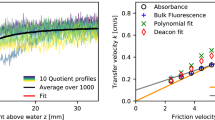Abstract
Planar laser-induced fluorescence (PLIF) is used to quantify spatiotemporal structure of gaseous scalar plumes (Sc \(\approx 1.5\)) in a benchtop-scale low-speed wind tunnel. The study is motivated by a desire to understand variations in information content in odor plumes used by animals for navigation. Acetone vapor is used as a fluorescent odor surrogate and is released isokinetically to form a neutrally buoyant plume. Three cases are investigated: a near-bed scalar release at 10 cm/s, a freestream scalar release at 10 cm/s, and a second freestream scalar release at 20 cm/s. PLIF image data are collected at 15 Hz and processed to provide distributions of instantaneous concentrations. Spatial distributions of mean concentration, root-mean-square fluctuations, and concentration intermittency are presented, along with probability density functions of concentrations at select locations. The results demonstrate significant differences in spatiotemporal structure of the scalar plumes across the three tested cases. In particular, the near-bed plume is markedly different from those released in the freestream. The results have important implications for understanding gaseous plume structure. Specifically, the results suggest that different flow and release conditions control constraints and opportunities for animals using odor plumes for navigational purposes.
Graphical abstract












Similar content being viewed by others
References
Ache BW, Young JM (2005) Olfaction: diverse species, conserved principles. Neuron 48:417–430
Bara BM, Wilson DJ, Zelt BW (1992) Concentration fluctuation profiles from a water channel simulation of a ground-level release. Atmos Environ 26A(6):1053–1062
Cetegen BM (2006) Scalar mixing in the field of a gaseous laminar line vortex. Exp Fluids 40:967–976
Crimaldi JP (2008) Planar laser induced fluorescence in aqueous flows. Exp Fluids 44:851–863
Crimaldi JP, Wiley MB, Koseff JR (2002) The relationship between mean and instantaneous structure in turbulent passive scalar plumes. J Turbul 3(014):1–24
Fackrell JE, Robins AG (1982) Concentration fluctuations and fluxes in plumes from point sources in a turbulent boundary layer. J Fluid Mech 117:1–26
Getsinger DR, Gevorkyan L, Smith OI, Karagozian AR (2014) Structural and stability characteristics of jets in crossflow. J Fluid Mech 760:342–367
Gevorkyan L, Shoji T, Getsinger DR, Smith OI, Karagozian AR (2016) Transverse jet mixing characteristics. J Fluid Mech 790:237–274
Justus KA, Murlis J, Jones C, Cardé RT (2002) Measurement of odor-plume structure in a wind tunnel using a photoionization detector and a tracer gas. Environ Fluid Mech 2:115–142
Kearney SP, Reyes FV (2003) Quantitative temperature imaging in gas-phase turbulent thermal convection by laser-induced fluorescence of acetone. Exp Fluids 34:87–97
Kothnur PS, Clemens NT (2005) Effects of unsteady strain rate on scalar dissipation structures in turbulent planar jets. Phys Fluids 17(125104):1–14
Liao Q, Cowen EA (2002) The information content of a scalar plume—a plume tracing perspective. Environ Fluid Mech 2:9–34
Lozano A, Yip B, Hanson RK (1992) Acetone: a tracer for concentration measurements in gaseous flows by planar laser-induced fluorescence. Exp Fluids 13:369–376
Lugg GA (1968) Diffusion coefficients of some organic and other vapors in air. Anal Chem 40(7):1072–1077
Markides CN, Mastorakos E (2006) Measurements of scalar dissipation in a turbulent plume with planar laser-induced fluorescence of acetone. Chem Eng Sci 61:2835–2842
Meyer TR, Dutton JC, Lucht RP (1999) Vortex interaction and mixing in a driven gaseous axisymmetric jet. Phys Fluids 11(11):3401–3415
Murlis J, Willis MA, Cardé RT (2000) Spatial and temporal structures of pheromone plumes in fields and forests. Physiol Entomol 25:211–222
O’Hern TJ, Weckman EJ, Gerhart AL, Tieszen SR, Schefer RW (2005) Experimental study of a turbulent buoyant helium plume. J Fluid Mech 544:143–171
Pickett LM, Ghandhi JB (2001) Passive scalar measurements in a planar mixing layer by PLIF of acetone. Exp Fluids 31:309–318
Rahman S, Webster DR (2005) The effect of bed roughness on scalar fluctuations in turbulent boundary layers. Exp Fluids 38:372–384
Schumaker SA, Driscoll JF (2012) Mixing properties of coaxial jets with large velocity ratios and large inverse density ratios. Phys Fluids 24(055101):1–21
Smith SH, Mungal MG (1998) Mixing, structure and scaling of the jet in crossflow. J Fluid Mech 357:83–122
Su LK, Clemens NT (2003) The structure of fine-scale scalar mixing in gas-phase planar turbulent jets. J Fluid Mech 488:1–29
Webster DR, Weissburg MJ (2001) Chemosensory guidance cues in a turbulent chemical odor plume. Limnol Oceanogr 46(5):1034–1047
Webster DR, Rahman S, Dasi LP (2003) Laser-induced fluorescence measurements of a turbulent plume. J Eng Mech 129(10):1130–1137
Wilson DJ, Robins AG, Fackrell JE (1985) Intermittency and conditionally-averaged concentration fluctuation statistics in plumes. Atmos Environ 19(7):1053–1064
Yee E, Kosteniuk PR, Chandler GM, Biltoft CA, Bowers JF (1993) Statistical characteristics of concentration fluctuations in dispersing plumes in the atmospheric surface layer. Bound Layer Meteorol 65:69–109
Acknowledgements
This work was supported by the National Science Foundation (USA), under Grant No. PHY 155586 to JPC
Author information
Authors and Affiliations
Corresponding author
Additional information
Publisher's Note
Springer Nature remains neutral with regard to jurisdictional claims in published maps and institutional affiliations.
Rights and permissions
About this article
Cite this article
Connor, E.G., McHugh, M.K. & Crimaldi, J.P. Quantification of airborne odor plumes using planar laser-induced fluorescence. Exp Fluids 59, 137 (2018). https://doi.org/10.1007/s00348-018-2591-3
Received:
Revised:
Accepted:
Published:
DOI: https://doi.org/10.1007/s00348-018-2591-3




